Grace Robert. Advanced Blowout and Well Control
Подождите немного. Документ загружается.

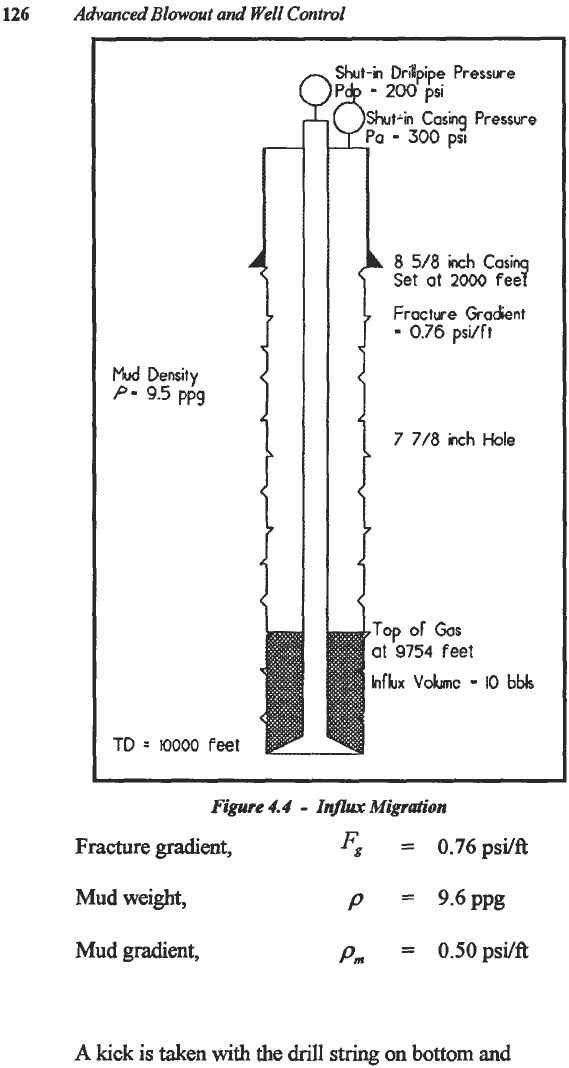
126
Advanced
Blowout
and Well Control
Mud
Density
P-
9.5
ppg
%ut-in
Drdpp
I
e
Pressure
-
200
psi
%!.in
Casing
Pressure
8
5/8
inch
Cosi
Set
at
2000
re3
Fracture Godent
-
0.76
psi/ft
7 7/8
inch
Hole
Top
of
Gas
hfkrx
Vokanc
-
IO
bbk
at
9754
feet
TD
=
IO000 feet
Figure
4.4
-
Injhc
Migration
Fracture
gradient,
<
=
0.76psVft
Mud
weight,
P
=
9-6PPg
Mud
gradient,
Pm
=
OSOpsi/ft
A
kick
is
taken with the
drill
string on
bottom
and
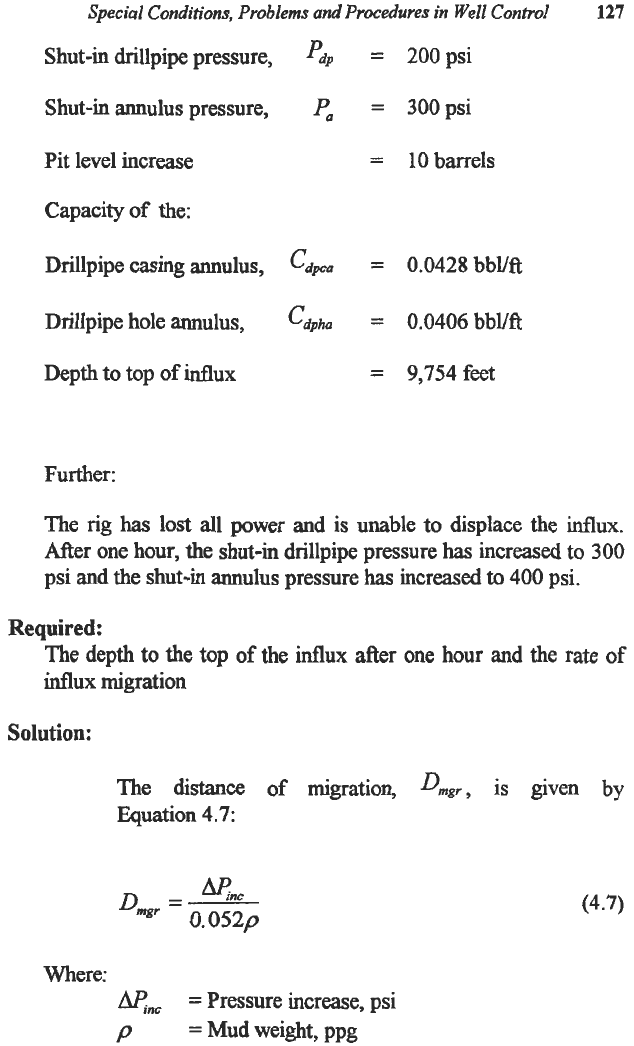
Special Conditions, Problems and Procedures in
Well
Control
127
Shut-in drillpipe pressure,
pdp
=
200
psi
Shut-in annulus pressure,
Pa
=
300
psi
Pit level increase
=
10
barrels
Capacity
of
the:
Drillpipe casing annulus,
Cdv
=
0.0428
bbVft
Drillpipe hole annulus,
Cdph
=
0.0406
bbVf€
Depth to top
of
influx
=
9,754
feet
Further:
The rig
has
lost all power and is unable to displace the
influx.
After one hour, the shut-in drillpipe pressure
has
increased to
300
psi and the shut-in annulus pressure
has
increased
to
400
psi.
Required:
The depth to the top
of
the influx after one hour and the rate
of
influx migration
Solution:
The
distance
of
migration7
Dmgr7
is given by
Equation
4.7:
Where:
wnc
=
Pressure increase, psi
P
=
Mud weight, ppg
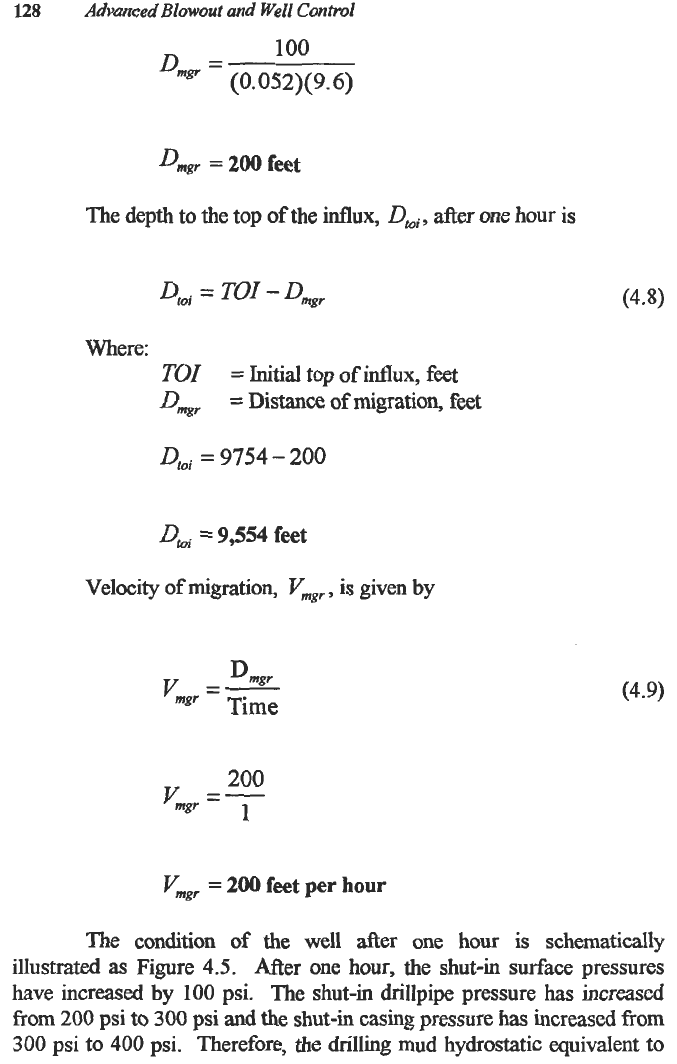
128
Advanced
Blowout
and
Well
Control
100
Dmgr
=
(0.052)(9.6)
Dmgr
=
200
feet
The depth to the top
of
the influx,
Dbi,
after one hour is
Dtoi
=
TO1
-
Dmgr
Where:
TO1
Dwr
=
Initial
top
of
influx,
feet
=
Distance
of migration, feet
0,.
=
9754
-
200
D,
=
9,554
feet
Velocity of migration,
Vmgr,
is
given by
Dmgr
y
=-
mgr
Time
(4.8)
(4.9)
Vmgr
=
200
feet per hour
The
condition of the well after one
hour
is
schematically
illustrated
as
Figure
4.5.
After one hour, the shut-in surface pressures
have increased
by
100
psi. The shut-in drillpipe pressure
has
increascd
from
200
psi to
300
psi and the shut-in casing pressure
has
increased
from
300
psi
to
400
psi. Therefore, the
drilling
mud hydrostatic equivalent to
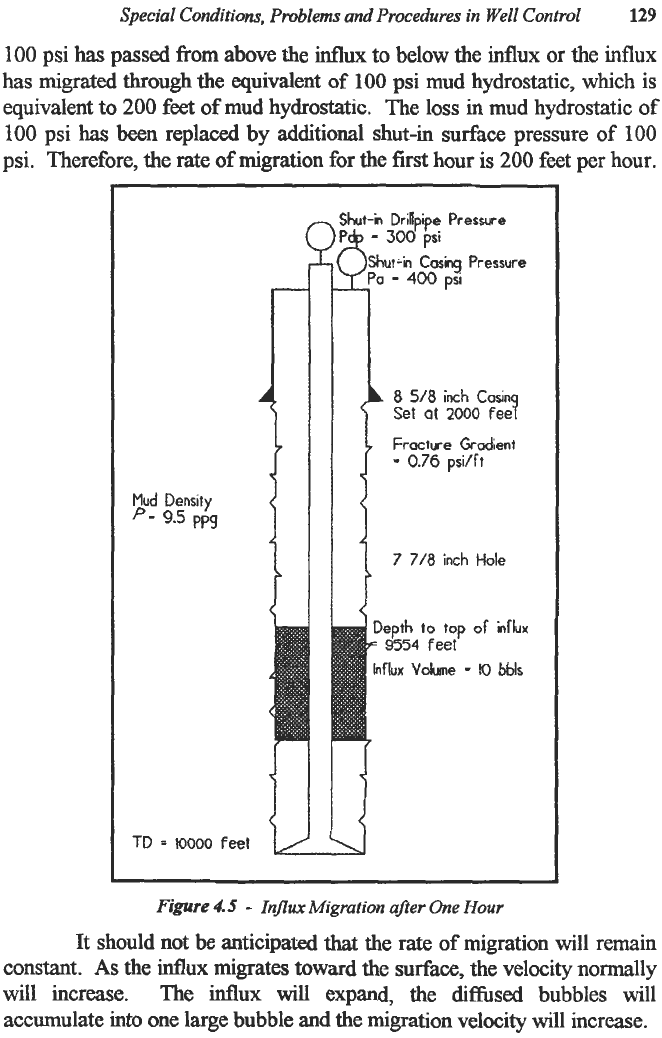
Special Conditions, Problems and Procedures
in
Well Control
129
100
psi
has
passed
from
above the
influx
to below the influx or
the
influx
has migrated
through
the equivalent
of
100
psi mud hydrostatic, which is
equivalent to
200
feet
of
mud hydrostatic. The loss in mud hydrostatic of
100
psi
has
been replaced by additional shut-in surface pressure
of
100
psi. Therefore, the rate of migration for the first hour
is
200
feet per hour.
Mud
Density
p-
9.5
ppg
8
518
inch
Coin
Set
at
2000
fee9
Fractve
Gradient
-
0.76
psi/Ft
7
718
inch
Hole
i
epth
to
top
of
idlux
9554
feet
flux
Vdume
-
0
bbls
TD
=
10000
feet
ku
Figure
4.5
-
Influx Migration after One Hour
It
should not be anticipated
that
the rate
of
migration will remain
constant.
As
the influx migrates
toward
the surface, the velocity normally
will increase. The influx
will
expand, the
diffused
bubbles will
accumulate into one large bubble and the migration velocity will increase.
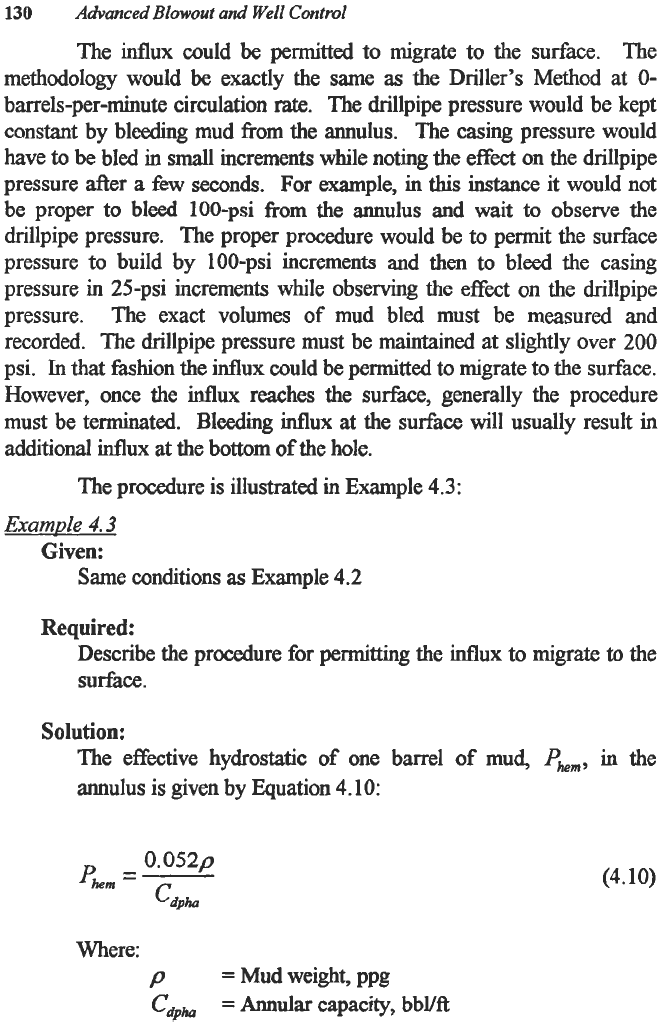
130
Advanced Blowout
and
Well
Control
The influx could
be
permitted to migrate to the surface. The
methodology would
be
exactly the same
as
the Driller’s Method at
0-
barrels-per-minute circulation
rate.
The drillpipe pressure would be kept
constant by bleeding mud from the annulus. The casing pressure would
have
to
be bled in small increments while noting the effect
on
the drillpipe
pressure after
a
few
seconds.
For
example, in
this
instance it would not
be proper to bleed 100-psi from the annulus and wait
to
observe the
drillpipe pressure. The proper procedure would be to permit the surface
pressure to build by 100-psi increments and then to bleed the casing
pressure
in
25-psi increments while observing the effect on the drillpipe
pressure. The exact volumes of mud bled must be measured and
recorded. The drillpipe pressure must be maintained at slightly over
200
psi.
In
that fashion the influx could be permitted to migrate to the surface.
However, once the influx reaches the surfhce, generally the procedure
must be terminated. Bleeding dux at the surface will usually result
in
additional influx at the bottom of the hole.
The procedure is illustrated in Example 4.3:
Examule
4.3
Given:
Same
conditions
as
Example 4.2
Required:
Describe the procedure for permitting the influx to migrate
to
the
surface.
Solution:
The effective hydrostatic
of
one barrel
of
mud,
Phem,
in the
annulus
is
given by Equation 4.10:
(4.10)
Where:
P
=
Mud weight, ppg
cdph
=
Annular capacity, bbVft
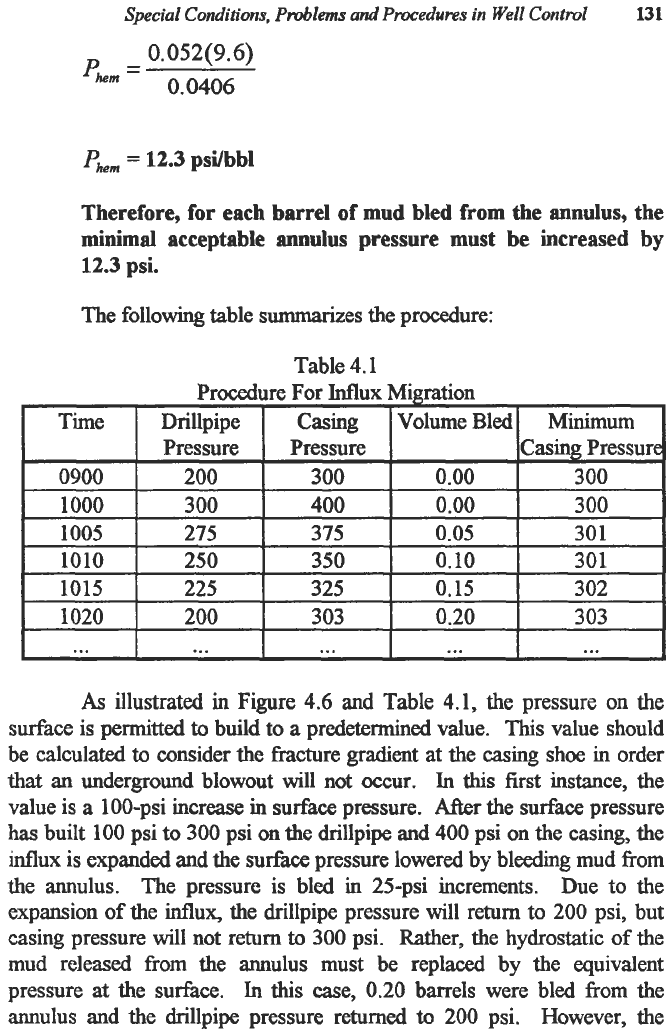
Special Conditions,
Problems
and
Procedures in
Well
Control
131
O.OSZ(9.6)
0.0406
Phm
=
Phem
=
12.3
psi/bbl
Therefore, for each
minimal acceptable
12.3
psi.
barrel of mud bled from the annulus, the
annulus
pressure must be increased by
The
following
table summarizes the procedure:
Table 4.1
As
illustrated in Figure
4.6
and Table
4.1,
the pressure on the
surface is permitted
to
build to
a
predetermined value.
This
value should
be calculated
to
consider the fracture gradient at the casing
shoe
in order
that
an
underground blowout
will
not occur. In
this
first instance, the
value
is
a 100-psi increase
in
surface pressure.
After
the surface pressure
has
built 100 psi to
300
psi on the drillpipe and 400 psi on the casing, the
influx is expanded and the surfkce pressure lowered by bleeding mud
from
the annulus.
The pressure is bled in 25-psi increments. Due to the
expansion
of
the
influx,
the drillpipe pressure
will
return to
200
psi, but
casing pressure
will
not return
to
300
psi. Rather, the hydrostatic of
the
mud released from the annulus must be replaced by the equivalent
pressure
at
the surface.
In
this case,
0.20
barrels were bled from the
annulus and the drillpipe pressure returned
to
200
psi. However, the
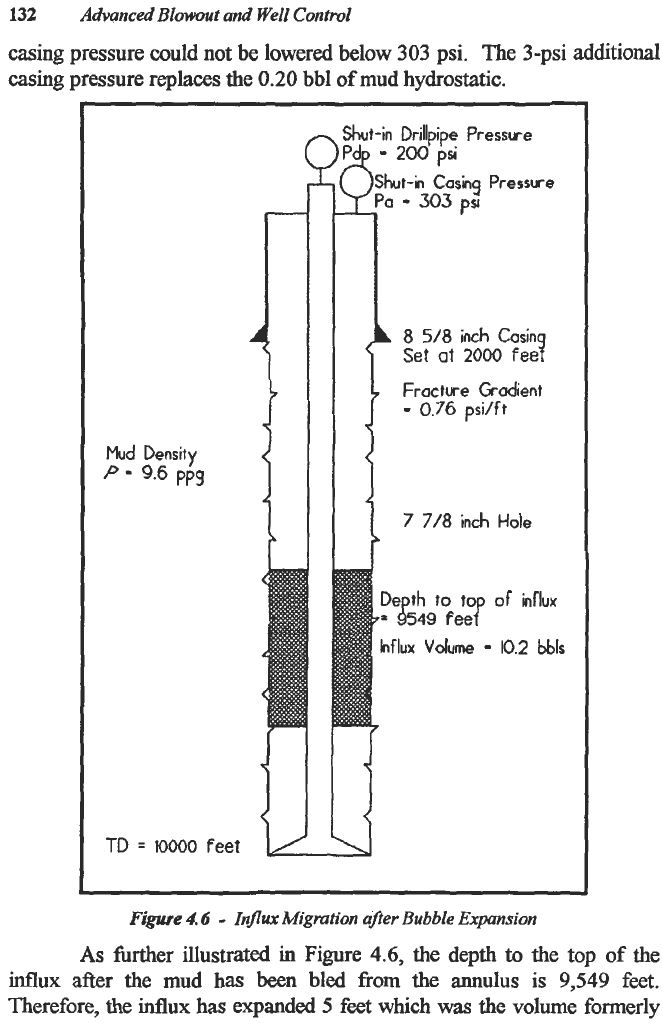
132
casing pressure could not be lowered below 303
psi.
The 3-psi
additional
casing pressure replaces the
0.20
bbl
of
mud hydrostatic.
Advanced
Blowout
and Well
Control
Mud
Density
P
-
9.6
ppg
Shut-in
Casing
Pressure
8
518
inch
Casin
Set
at
2000
fee?
Fracture
Gdent
-
0.76
pdft
De
th
to
to
of
influx
=
L9
fee!'
Influx
Vdume
-
10.2
bbls
Figwe
4.6
-
Influx
Migmtion
after Bubble Expansion
As
further illustrated
in
Figure
4.6,
the depth
to
the top
of
the
influx after
the
mud
has
been
bled
from
the annulus
is
9,549
feet.
Therefore, the influx
has
expanded
5
feet
which
was
the volume formerly
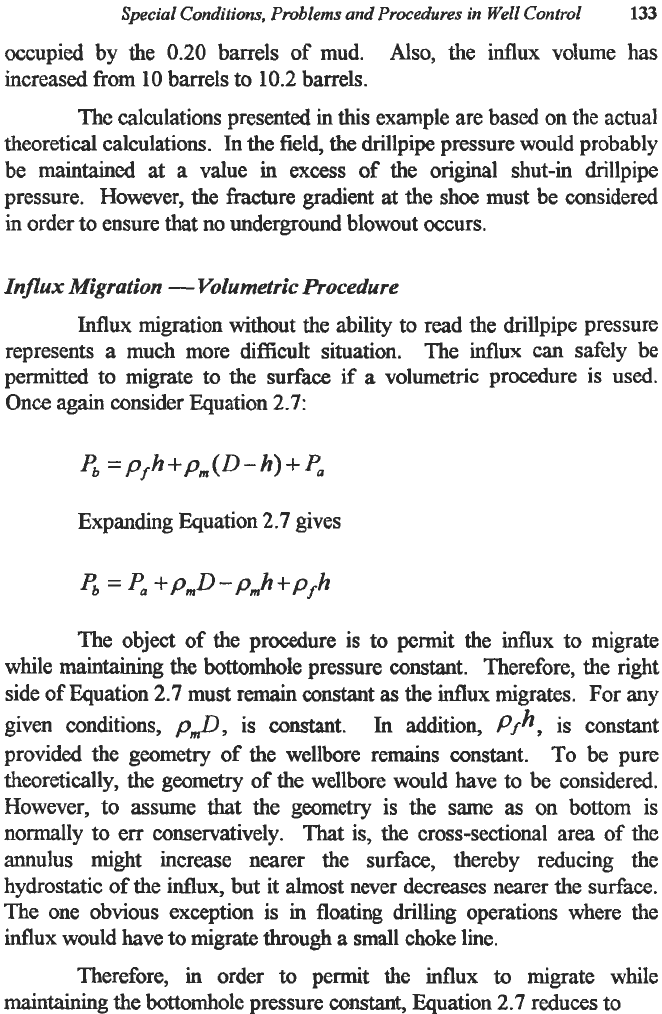
Special
Conditions, Problems and Procedures
in
Well
Control
133
occupied by the 0.20 barrels of mud.
Also,
the influx volume has
increased from 10 barrels to 10.2 barrels.
The calculations presented in this example are based on the actual
theoretical calculations. In the field, the drillpipe pressure would probably
be maintained
at
a value
in
excess
of
the original shut-in drillpipe
pressure. However, the
fracture
gradient
at
the shoe must be considered
in order to ensure
that
no underground blowout occurs.
Influx Migration
-
Volumetric Procedure
Influx migration without the ability to read the drillpipe pressure
represents
a
much more difficult situation. The influx
can
safely be
permitted to migrate
to
the surface
if
a
volumetric procedure is used.
Once again consider Equation 2.7:
pb
=pfh+p,(D-h)+P,
Expanding Equation 2.7 gives
The object
of
the procedure is to permit the influx to migrate
while maintaining the bottomhole pressure constant. Therefore, the right
side of Equation
2.7
must remain constant
as
the influx migrates. For any
given conditions,
p,~,
is constant. In addition,
Pfh,
is constant
provided the geometry of the wellbore remains constant.
To
be pure
theoretically, the geometry of the wellbore would have to be considered.
However, to assume
that
the geometry is the same
as
on bottom is
normally to
err
conservatively.
That
is, the cross-sectional area
of
the
annulus might increase nearer the surface, thereby reducing the
hydrostatic of the influx, but it almost never decreases nearer the surface.
The one obvious exception
is
in
floating drilling operations where the
influx would have to migrate through a small choke line.
Therefore, in order
to
permit the influx
to
migrate while
maintaining the bottomhole pressure constant, Equation 2.7 reduces to
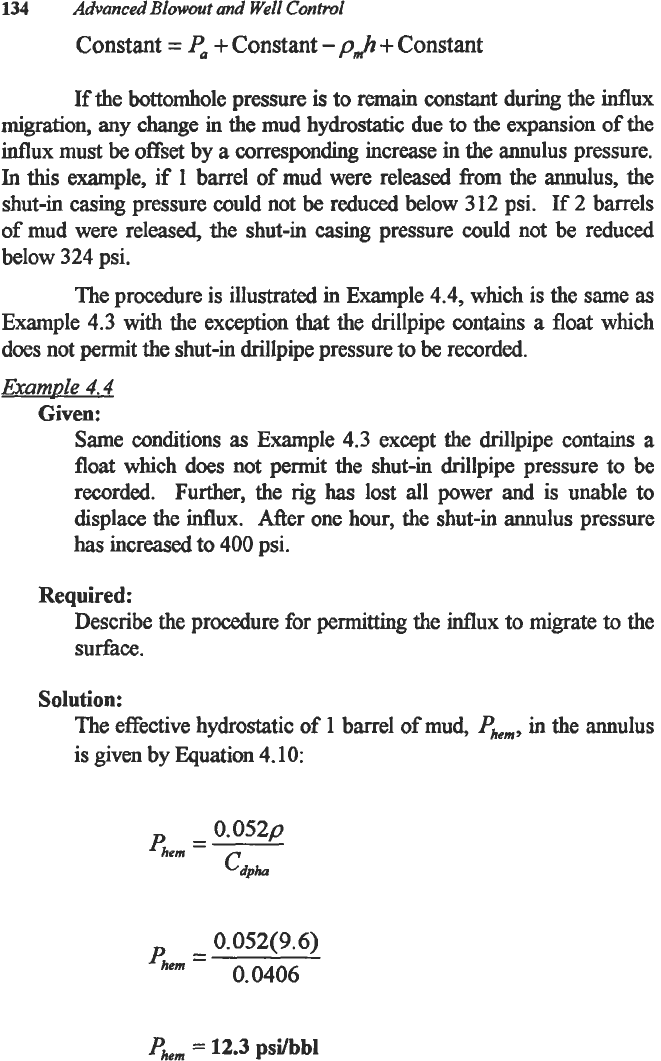
134
Advanced
Blowout
and Well
Control
Constant
=
P,
+
Constant
-
pJ
+
Constant
If the bottomhole pressure is to remain constant during the
influx
migration, any change in the mud hydrostatic due to the expansion of the
influx must
be
offset
by
a
correspondmg increase in the annulus pressure.
In
this
example, if
1
barrel of mud were released from the annulus, the
shut-in casing pressure could not
be
reduced below 312 psi. If 2 barrels
of
mud were released, the shut-in casing pressure could not be reduced
below 324 psi.
The procedure is illustrated in Example 4.4, which
is
the same
as
Example 4.3 with the exception that the drillpipe
contains
a
float which
does
not permit the shut-in drillpipe pressure
to
be
recorded.
Example
4.4
Given:
Same conditions
as
Example 4.3 except the drillpipe contains a
float
which does not permit the shut-in drillpipe pressure to
be
recorded. Further, the rig
has
lost all power and is unable to
displace the
influx.
After one hour, the shut-in annulus pressure
has increased
to
400 psi.
Required:
Describe the procedure for permitting the influx to migrate
to
the
surface.
So
1
uti
o
n
:
The effective hydrostatic of 1 barrel
of
mud,
phenr,
in the annulus
is given by Equation 4.10:
0.052~
p
=-
hem
G*ha
0.052(9.6)
0.0406
4em
=
&em
=
12.3
pdbbl
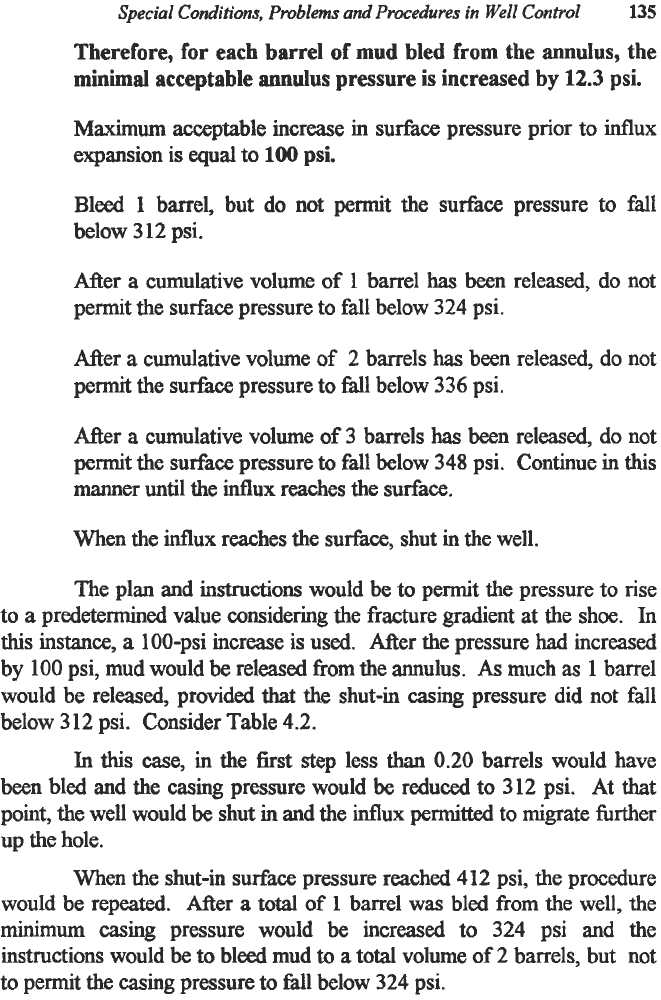
Special
Conditions, Problems
and
Procedures in
Well
Control
135
Therefore, for each barrel of mud bled from the
annulus,
the
minimal acceptable annulus pressure
is
increased by
12.3
psi.
Maximum
acceptable increase in surface pressure prior to influx
expansion is equal to
100
psi.
Bleed
1
barrel, but do not permit the surface pressure to fall
below
3
12
psi.
After a cumulative volume of
1
barrel
has
been
released, do not
permit the surface pressure to fall below
324
psi.
After
a
cumulative volume of
2
barrels
has
been released, do not
permit the surface pressure to Ml below
336
psi.
After a cumulative volume
of
3
barrels
has
been released, do not
permit the surface pressure
to
fall below
348
psi. Continue in
this
manner until the influx reaches the surface.
When the influx reaches the surfkce, shut in the well.
The plan and
instructions
would be
to
permit the pressure to rise
to
a
predetermined value considering the fracture gradient at the shoe. In
this
instance,
a
100-psi increase is used. After the pressure had increased
by
100 psi, mud would be released from the annulus.
As
much
as
1
barrel
would be released, provided that the shut-in casing pressure did not fall
below
3
12 psi. Consider Table
4.2.
In
this
case,
in
the first
step
less than
0.20
barrels would have
been bled and the casing pressure would be reduced to
312
psi. At
that
point, the well would
be
shut in and the influx
permitted
to
migrate
krther
up the hole.
When the shut-in surface pressure reached
412
psi, the procedure
would be repeated. After
a
total
of
1 barrel
was
bled
from
the well, the
minimum
casing pressure would be increased to
324
psi and the
instructions would be to bleed mud
to
a
total volume of
2
barrels, but not
to permit the
casing
pressure
to
fall below
324
psi.
